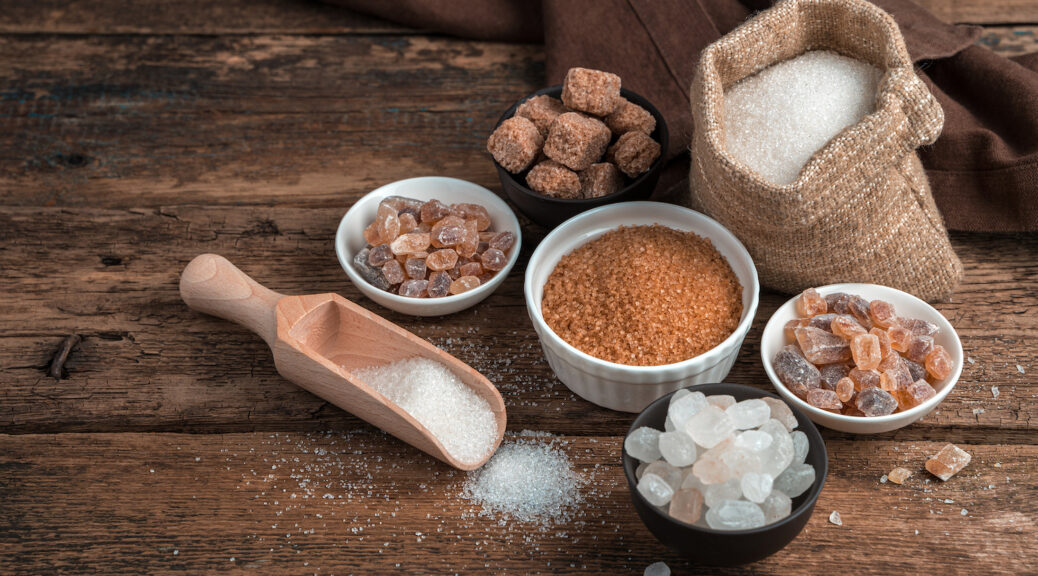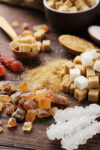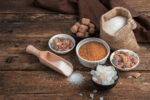
About Sugars and Syrups
Sugar cane was first planted in the United States in Louisiana in 1751. But sugar beets weren’t planted until 1836, near Philadelphia. (source) Until the sugar industry in the U.S. became established, sugar had to be imported and was scarce and expensive.
INFORMATION BELOW FROM 1800s COOKBOOKS
Granulated sugar is made either from the sugar cane or sugar beet. The juice is pressed or soaked out of these plants, then purified, refined, and crystallized.
~ Powdered sugar is prepared by crushing granulated sugar.
~ Confectioners’ sugar is a very finely ground form of cane or beet sugar.
~ Granulated sugar is 100 per cent sugar. Crushed sugars sometimes contain flour or other materials.
~ Brown sugar is made from the cane or beet, but is not refined as much as is granulated sugar. It contains some ash and moisture.
~ The sugar beet contains from seven to thirteen per cent of sugar, which, when raw, is unpleasant, but when refined is identical with cane sugar.
TO CLARIFY SUGAR
To two pounds of loaf sugar, add one quart of water. When the sugar is dissolved, add the whites of two eggs well beaten. Let it boil slowly until the scum has ceased rising, then pour through a strainer.
CARAMELIZED SUGAR
It should be noted that when heat is applied to granulated sugar, the latter liquefies and becomes brown in color. This brown liquid is called caramel The process of making it is called caramelization.
When sugar is caramelizing, it reaches a high temperature. The melting point of tin is near the temperature of caramelized sugar. The enamel of granite ware is apt to chip off if subjected to great changes of temperature. Iron is not affected by the highest cooking temperature, hence it is desirable to use an iron utensil for caramelizing sugar.
MOLASSES
Molasses is a by-product of cane sugar. In addition to sugar, it contains certain mineral materials such as lime. Since it is especially necessary that foods given children contain lime, the use of molasses in place of sugar may be recommended for children.
One should remember, however, that much sugar of any kind is not good for children. Molasses contains some acid. Because of modern methods of sugar refining, however, molasses is less acid than the syrup of former days. It also differs in flavor.
CORN SYRUP
Corn syrup is made by boiling corn-starch with an acid and then refining the product. This syrup contains no cane sugar. Its sweet flavor and syrupy consistency are due to the presence of 38.5 per cent glucose and 42 per cent dextrin. Glucose is not as sweet as granulated sugar. Hence, in depending upon corn syrup alone, the tendency is to use more sugar than is advisable so as to satisfy our taste for sweets. At least 1 1/2 times as much corn syrup as granulated sugar is needed to produce the sweetness of the solid sugar. A mixture of corn syrup and granulated sugar is often used for sweetening foods.
SORGHUM
Sorghum is a syrup prepared from the sorghum plant. It contains ash and has a characteristic flavor. If the flavor of molasses or sorghum is too strong to be pleasant, a mixture of equal parts of corn syrup and molasses or sorghum may be found desirable. Mixtures of different syrups sold under various trade names may be purchased.
MAPLE SYRUP AND SUGAR
Maple syrup and sugar are prepared from sap extracted from the maple tree. They both have a distinctive flavor in addition to their sweet taste. Maple sugar contains approximately 83 per cent of sugar, while maple syrup contains about 71 per cent.
The sap of the sugar maple contains about two per cent of maple sugar, which is identical with cane sugar, and may be made white, but is preferred brown, as containing more of the rich maple flavor. About seven thousand tons of maple sugar are annually made in the New England States. Maple syrup is extensively sold by grocers in cans, bottles, etc.

